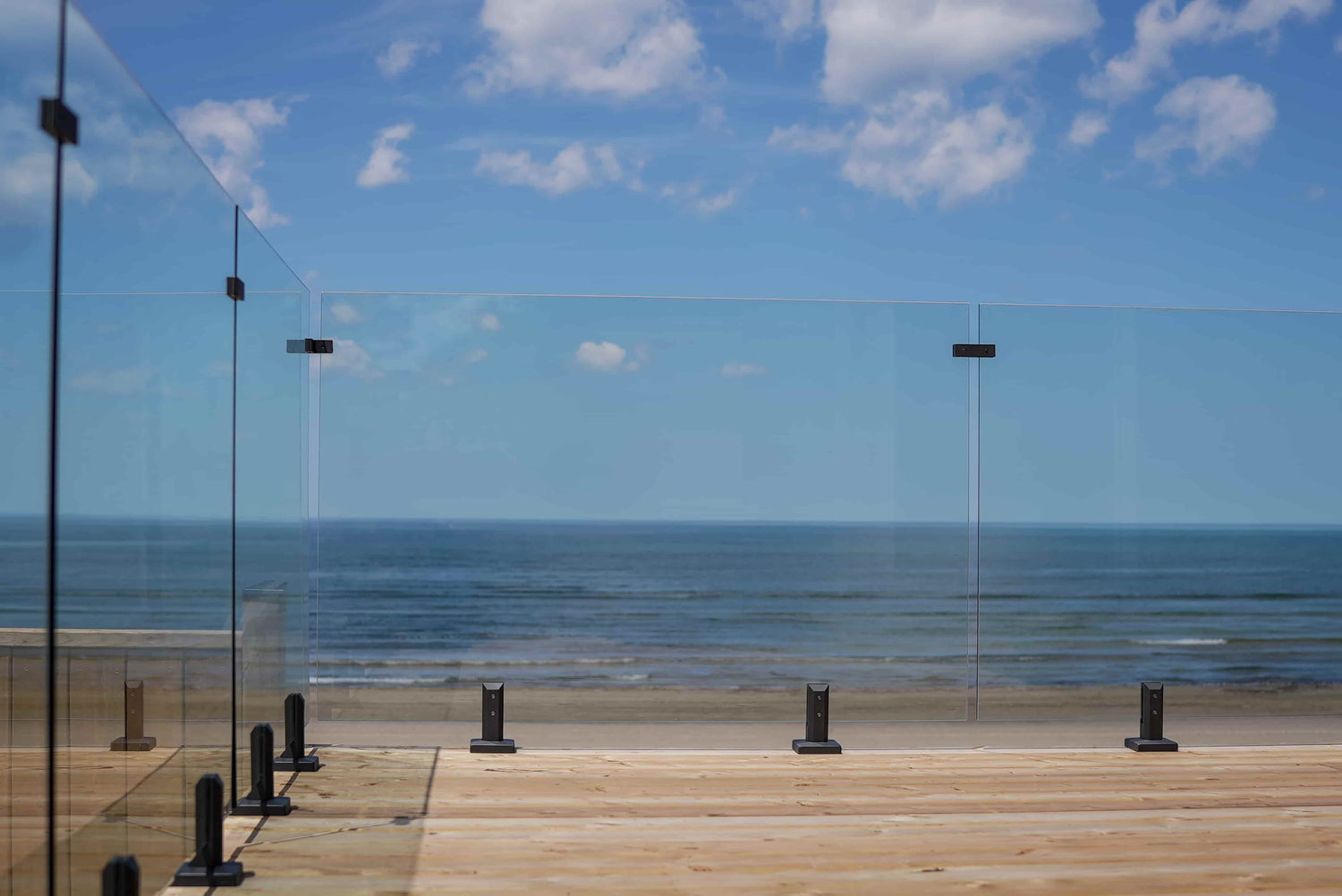Alabama Building Code for Glass Railings

The Alabama Building Code (ABC) is an essential document that guides construction work in Alabama’s building industry. It is a crucial compliance guideline that governs new and remodeling projects.
In addition, the ABC offers detailed glass railing requirements that specify where guardrails are mandatory within buildings. More specifically, this code guides you regarding glazing and guard railing specifications.
Keep reading to learn more about Alabama glass railing requirements!
About the Alabama Building Code
The 2021 version of the Alabama Building Code is the current compliance guideline in this state. This version of the code, based on the 2021 International Building Code (IBC), was adopted on July 21, 2022.
On the other hand, the IBC is a global guideline for building construction and it is widely adopted by many American States. This code is reviewed every 3 years to promote user safety in a built environment.
The International Building Code offers several benefits, including the following.
- It is based on the principles of public health, welfare, and safety.
- It promotes design flexibility and efficiency for architects, engineers, and other designers.
- It encourages the use of newer technologies.
- The code is based on nationally recognized construction standards.
- It gives room for using tested and tried solutions.
Where Glass Railing Systems are Required

Guardrails, especially frameless railings can transform any home into a sleek and modern abode. However, there are rules governing the use of these systems.
The Alabama Building Code mandates the installation of glass railings in specific elevated platforms, which include ramps, stairways, decks, and balconies. Likewise, these compliance guidelines cut across private and public buildings.
In addition, safety regulations across Alabama apply to indoor and outdoor spaces as stated below.
- Installation of guardrails is mandatory for elevated platforms that are 762 mm (30 inches) high above the adjacent floor.
- The Occupational Safety and Health Administration (OSHA) does not allow openings on frameless glass railings that are wider than 100 mm (4 inches) in diameter. This regulation helps protect children from passing through and falling off elevated surfaces.
- Building safety regulations mandate glass deck railings and other guardrails to withstand a linear load of 50 lbs as specified by the American Society of Civil Engineers.
Specifications for Glass Guardrails
Alabama Building Code glass railing requirements are designed to prioritize user and building safety. For this reason, this code covers the glass railing system location, height, and glass panel requirements.
It also specifies pool fencing safety regulations.
Guardrail Location Specifications
All elevated platforms with open-sided and walking surfaces like balconies, decks, ramps, and stairways must have railings. The exceptions to these compliance guidelines are as follows:
- Loading sides for piers and docks;
- Raised performance stages or platforms;
- Car service pits;
- Aisles in assembly gatherings.
Guard Railing Height Specifications
Alabama Building Code requires glass guardrails to reach a particular height to ensure building safety. All measurements must be done vertically from the surface of the adjacent floor.
- For residential buildings, frameless glass railings must be at least 914 mm (36 inches) high for platforms elevated 762 mm (30 inches) above the floor.
- Commercial buildings must have guardrails at least 1067 mm (42 inches) high, regardless of the platform's height.
- If they wish to, residential building owners are free to extend the height of their glass deck railings to 1067 mm (42 inches).
- Handrails may be required to support disabled people when there is a minimum drop of 762 mm (30 inches).
Glazing Specifications
Glazing specifications involve glass thickness, quality, composition, and physical appearance. The Alabama Building Code specifies these requirements as follows.
- Glass panels used in guards must be at least 12 mm (0.5 inches) thick. Pool fencing and similar locations may require thicker glazing.
- Glass panels used for framed and frameless glass railings must be heath-strengthened or full-tempered laminated glass that complies with Class A of ANSI Z97 or Category II of CPSC 16 CFR Part 1201.
- The color or shade of a glass panel does not matter.
- Glass panels shall not have any cracks, chips, or visible imperfections.
Pool Enclosure

Pools, hot tubs, bathtubs, whirlpools, and other recreational require fencing if the depth is 610 mm (24 inches). These building safety compliance guidelines are put in place to protect children from drowning and restrict unauthorized access to the swimming area.
- Pool enclosures are required to reach a minimum height of 1220 mm (48 inches).
- Fencing cannot have an opening at the bottom or top that allows passage of a spherical body wider than 100 mm (4 inches).
- Access into the enclosure must be equipped with self-latching and self-locking gates.
- Openings and projections that allow climbing should not be fixed into glass railing fencing.
You should pay attention to the Alabama Building Code for glass railings before installing a pool or similar structures. Furthermore, local laws may expand these requirements.
Tips for Maintaining Functional Glass Railing Systems
Maintaining your glass guardrails can extend their lifespan beyond expectation. However, to achieve this, you should first hire a professional to design and install glass railing systems.
As such, ensure you adhere to the following maintenance tips.
- You should regularly clean and polish frameless glass railings using appropriate cleaning agents that do not corrode the supporting structure of the system.
- Applying UV protection should dampen the effect of sun rays on glass railings.
- Ensure you carefully examine each component of the railing system for faults and loose connections. Take proactive steps to correct problems once detected.
- Frameless glass railings can be slippery, especially when installed outdoors and in a wet environment. In this case, using an anti-slip agent on the guard railings should enhance user safety.
Conclusion
Alabama Building Code is a helpful tool for the construction and installation of projects and products within the state. It is based on the International Building Code (IBC), guiding homeowners and contractors through the design and installation of glass railings.
Furthermore, this code specifies glass railing requirements that define the obligation of guard installation. It also defines location, system rules, and glazing safety regulations.
Strict adherence to maintenance tips can improve user safety. It can also increase the lifespan of glass guardrails.
Alabama Building Code for Glass Railings FAQs
What building code does Alabama use?
Alabama adopted the International Building Code as the compliance guideline for the state on July 21, 2022. Therefore, the current Alabama Building Code is based on the 2021 version of the International Building Code.
How tall are glass railings?
Guardrails for homes and other residential buildings should start at 914 mm (36 inches). However, commercial and public buildings require guard railings to be at least 1067 mm (42 inches) tall.
Where can you put tempered glass?
Tempered glass can be used as panels in framed and frameless glass railing systems. Due to its durability, thickness, and safety compliance, this glazing type is suitable for all locations that require guardrails, including pools, balconies, and rooftops.
How far can the glass railing span?
A glass railing can safely span up to 6 ft after which the support structure must connect to the next panel in the guardrail system.
Let customers speak for us

Glass Railing Near You
Discover how The Glass Railing Store has been delivering exceptional service to our customers, thanks to our dedicated and knowledgeable team and their love our glass railing products.







